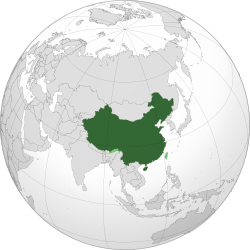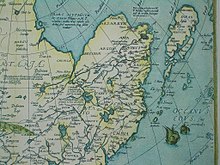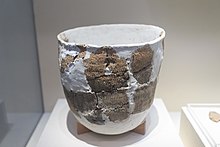
A | B | C | D | E | F | G | H | CH | I | J | K | L | M | N | O | P | Q | R | S | T | U | V | W | X | Y | Z | 0 | 1 | 2 | 3 | 4 | 5 | 6 | 7 | 8 | 9
People's Republic of China | |
|---|---|
| Anthem: "March of the Volunteers" | |
 Location of the People's Republic of China | |
| Capital | Beijing 39°55′N 116°23′E / 39.917°N 116.383°E |
| Largest city by city proper | Chongqing |
| Largest city by urban population | Shanghai |
| Official languages | Standard Chinese (de facto)[1] |
| Simplified characters | |
| Ethnic groups (2020)[2] |
|
| Religion (2023)[3] |
|
| Demonym(s) | Chinese |
| Government | Unitary Marxist–Leninist one-party socialist republic |
| Xi Jinping | |
• Premier | Li Qiang |
| Zhao Leji | |
| Wang Huning | |
| Han Zheng | |
| Legislature | National People's Congress[c] |
| Formation | |
| c. 2070 BCE | |
| 221 BCE | |
| 1 January 1912 | |
| 24 October 1945[d] | |
| 1 October 1949 | |
| 20 September 1954 | |
| 4 December 1982 | |
| 20 December 1999 | |
| Area | |
• Total | 9,596,961 km2 (3,705,407 sq mi)[e][6] (3rd / 4th) |
• Water (%) | 2.8[7] |
| Population | |
• 2023 estimate | |
• Density | 145[9]/km2 (375.5/sq mi) (83rd) |
| GDP (PPP) | 2024 estimate |
• Total | |
• Per capita | |
| GDP (nominal) | 2024 estimate |
• Total | |
• Per capita | |
| Gini (2020) | medium |
| HDI (2022) | high (75th) |
| Currency | Renminbi (元/¥)[g] (CNY) |
| Time zone | UTC+8 (CST) |
| Date format | YMD |
| Driving side | |
| Calling code | |
| ISO 3166 code | CN |
| Internet TLD | |
China,[h] officially the People's Republic of China (PRC),[i] is a country in East Asia. With a population exceeding 1.4 billion, it is the world's second-most populous country after India and contains 17.4% of the world population. China spans the equivalent of five time zones and borders fourteen countries by land.[j] With an area of nearly 9.6 million square kilometers (3,700,000 sq mi), it is the third-largest country by total land area.[k] The country is divided into 33 province-level divisions: 22 provinces,[l] five autonomous regions, four municipalities, and two semi-autonomous special administrative regions. Beijing is the country's capital, while Shanghai is its most populous city by urban area and largest financial center.
A cradle of civilization, China has been inhabited since the Paleolithic era, with the earliest dynasties emerging in the Yellow River basin before the late second millennium BCE. The eighth to third centuries BCE saw a breakdown in the authority of the Zhou dynasty, accompanied by the emergence of administrative and military techniques, literature, philosophy, and historiography. In 221 BCE, China was unified under an emperor for the first time. Appointed non-hereditary officials began ruling counties instead of the aristocracy, ushering in more than two millennia of imperial dynasties including the Qin, Han, Tang, Yuan, Ming, and Qing. With the invention of gunpowder and paper, the establishment of the Silk Road, and the building of the Great Wall, Chinese culture—including languages, traditions, architecture, philosophy and technology—flourished and has heavily influenced East Asia and beyond. However, China began to cede parts of the country in the late 19th century to various European powers by a series of unequal treaties.
After decades of struggle, the monarchy was overthrown in 1912 and the Republic of China (ROC) was formed, although the country in the Beiyang era became unstable which resulted in the Warlord Era, that later concluded after the Kuomintang (KMT) reunified the country while the Chinese Communist Party (CCP), purged after 1927, were fighting sporadically against the Nationalist government, with a brief truce as a united front when Japan began invading the country. Despite China's eventual victory in the Second Sino-Japanese War and the Pacific War in general, numerous atrocities such as the Nanjing Massacre left lasting effects on the country. After the war ended, it recovered the territories that Japan annexed but the second phase of the Chinese Civil War resumed shortly after, and by 1949, the CCP had established control on most of the territories of the country. As the KMT retreated to the island of Taiwan, the country was split with both sides claiming to be the sole legitimate government of China. After the land reforms, later attempts to realize communism failed—the Great Leap Forward led to a massive famine of millions of citizens, while the Cultural Revolution caused a chaotic period of persecution and zealous Maoist populism. In 1971, the PRC replaced the ROC as China's representation in the United Nations (UN). Following the Sino-Soviet split, the Shanghai Communiqué in 1972 marked the beginning of normalized relations with the United States. Economic reforms that began in 1978 led by reformists within the CCP moved the country away from a socialist planned economy toward an increasingly capitalist market economy, spurring significant economic growth, although liberal and democratic political reforms stalled after the Tiananmen Square massacre in 1989.
China is a unitary one-party socialist republic led by the CCP. It is a founding member of the UN and one of the five permanent members of the UN Security Council. It is a founding member of several multilateral and regional organizations such as the AIIB, the Silk Road Fund, the New Development Bank, and the RCEP. It is a member of the BRICS, the G20, APEC, the SCO, and the East Asia Summit. Making up around one-fifth of the world economy, the Chinese economy is the world's largest economy by GDP at purchasing power parity, the second-largest economy by nominal GDP, and the second-wealthiest country, albeit ranking poorly in measures of democracy, human rights and religious freedoms. The country has been one of the fastest-growing major economies and is the world's largest manufacturer and exporter, as well as the second-largest importer. China is a nuclear-weapon state with the world's largest standing army by military personnel and the second-largest defense budget. It is a great power and a regional power. China is known for its cuisine, culture and has 57 UNESCO World Heritage Sites.
Etymology

The word "China" has been used in English since the 16th century; however, it was not used by the Chinese themselves during this period. Its origin has been traced through Portuguese, Malay, and Persian back to the Sanskrit word Cīna, used in ancient India.[15] "China" appears in Richard Eden's 1555 translation[m] of the 1516 journal of the Portuguese explorer Duarte Barbosa.[n][15] Barbosa's usage was derived from Persian Chīn (چین), which in turn derived from Sanskrit Cīna (चीन).[20] Cīna was first used in early Hindu scripture, including the Mahabharata (5th century BCE) and the Laws of Manu (2nd century BCE).[21] In 1655, Martino Martini suggested that the word China is derived ultimately from the name of the Qin dynasty (221–206 BCE).[22][21] Although use in Indian sources precedes this dynasty, this derivation is still given in various sources.[23] The origin of the Sanskrit word is a matter of debate.[15] Alternative suggestions include the names for Yelang and the Jing or Chu state.[21][24]
The official name of the modern state is the "People's Republic of China" (simplified Chinese: 中华人民共和国; traditional Chinese: 中華人民共和國; pinyin: Zhōnghuá rénmín gònghéguó). The shorter form is "China" (中国; 中國; Zhōngguó), from zhōng ('central') and guó ('state'), a term which developed under the Western Zhou dynasty in reference to its royal demesne.[o][p] It was used in official documents as an synonym for the state under the Qing.[27] The name Zhongguo is also translated as 'Middle Kingdom' in English.[28] China is sometimes referred to as "mainland China" or "the Mainland" when distinguishing it from the Republic of China.[29][30][31][32]
History
Prehistory

Archaeological evidence suggests that early hominids inhabited China 2.25 million years ago.[33] The hominid fossils of Peking Man, a Homo erectus who used fire,[34] have been dated to between 680,000 and 780,000 years ago.[35] The fossilized teeth of Homo sapiens (dated to 125,000–80,000 years ago) have been discovered in Fuyan Cave.[36] Chinese proto-writing existed in Jiahu around 6600 BCE,[37] at Damaidi around 6000 BCE,[38] Dadiwan from 5800 to 5400 BCE, and Banpo dating from the 5th millennium BCE. Some scholars have suggested that the Jiahu symbols (7th millennium BCE) constituted the earliest Chinese writing system.[37]
Zdroj:https://en.wikipedia.org?pojem=ChinaText je dostupný za podmienok Creative Commons Attribution/Share-Alike License 3.0 Unported; prípadne za ďalších podmienok. Podrobnejšie informácie nájdete na stránke Podmienky použitia.
Antropológia
Aplikované vedy
Bibliometria
Dejiny vedy
Encyklopédie
Filozofia vedy
Forenzné vedy
Humanitné vedy
Knižničná veda
Kryogenika
Kryptológia
Kulturológia
Literárna veda
Medzidisciplinárne oblasti
Metódy kvantitatívnej analýzy
Metavedy
Metodika
Text je dostupný za podmienok Creative
Commons Attribution/Share-Alike License 3.0 Unported; prípadne za ďalších
podmienok.
Podrobnejšie informácie nájdete na stránke Podmienky
použitia.
www.astronomia.sk | www.biologia.sk | www.botanika.sk | www.dejiny.sk | www.economy.sk | www.elektrotechnika.sk | www.estetika.sk | www.farmakologia.sk | www.filozofia.sk | Fyzika | www.futurologia.sk | www.genetika.sk | www.chemia.sk | www.lingvistika.sk | www.politologia.sk | www.psychologia.sk | www.sexuologia.sk | www.sociologia.sk | www.veda.sk I www.zoologia.sk


